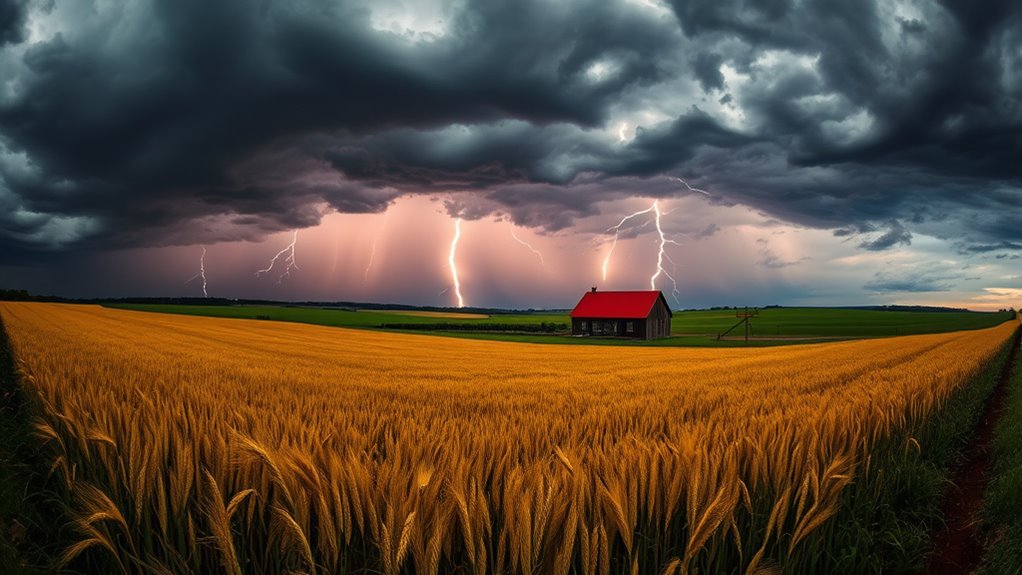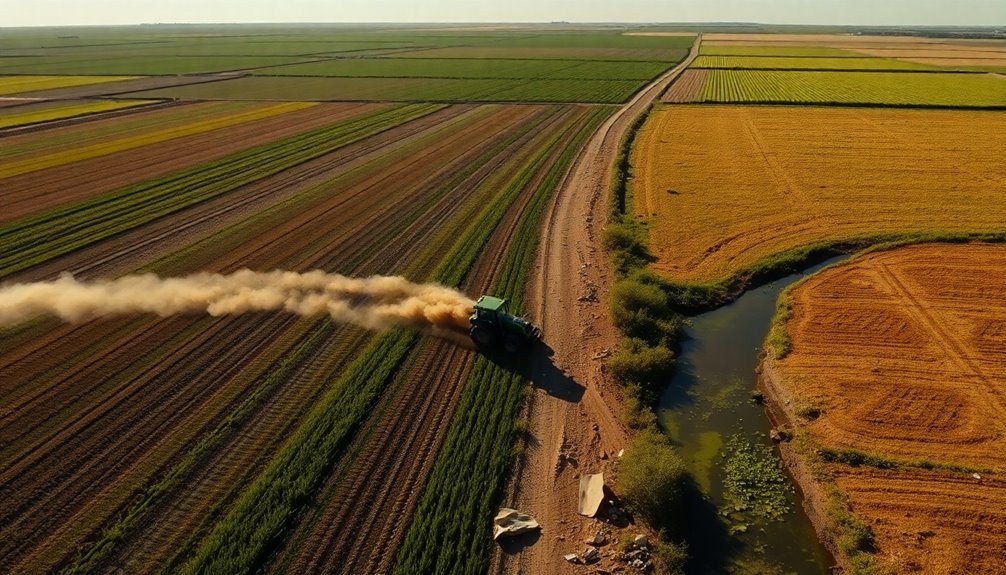To choose farm insurance for extreme weather, start by evaluating your farm’s vulnerabilities—identify crops, livestock, and infrastructure most at risk. Explore coverage options like crop, property, and livestock insurance, and consider additional endorsements for flood or windstorm protection. Verify the insurer’s reputation for reliable claims processing and evaluate costs versus coverage needs. Keeping thorough records can streamline claims later. Keep these steps in mind, and you’ll be better prepared when severe weather strikes.
Key Takeaways
- Assess your farm’s specific vulnerabilities and identify coverage gaps related to extreme weather risks.
- Choose insurers with strong reputations for reliability, prompt claims processing, and long-term support.
- Ensure policies include necessary endorsements like flood, windstorm, or hail riders for comprehensive protection.
- Compare coverage options and premiums to find cost-effective plans that match your farm’s risk profile.
- Maintain detailed records of assets, losses, and weather events to facilitate smooth and rapid claims.
Assessing Your Farm’s Vulnerabilities to Extreme Weather

Understanding your farm’s vulnerabilities to extreme weather is essential for effective risk management. You need to identify which parts of your farm are most at risk, whether it’s crops prone to drought, livestock vulnerable to storms, or irrigation systems susceptible to flooding. Evaluate your location’s history with weather events like hurricanes, heavy snowfall, or heatwaves. Consider how these events could impact your operations, equipment, and infrastructure. Take stock of your current resilience measures and gaps. By understanding these vulnerabilities, you can prioritize areas that need strengthening. This assessment helps you develop targeted strategies to minimize damage and plan for recovery. Knowing your specific risks ensures you choose the right insurance coverage and implement proactive measures tailored to your farm’s unique needs. Additionally, understanding the role of AI technologies in weather prediction can enhance your preparedness and response planning.
Understanding the Types of Coverage Available
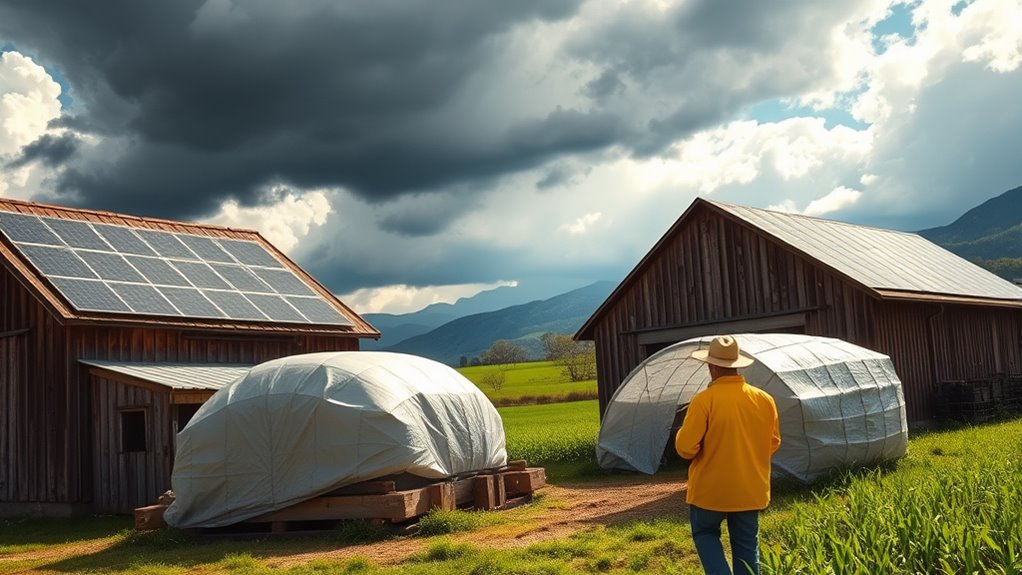
Understanding the types of coverage available helps you safeguard your farm against extreme weather events. You can choose policies that cover your crops and livestock, property and equipment, or include natural disaster clauses for added protection. Knowing your options ensures you select the coverage best suited to your farm’s needs.
Crop and Livestock Protection
When it comes to protecting your farm from extreme weather events, knowing your options for crop and livestock coverage is essential. Crop insurance can shield you from losses caused by droughts, floods, hail, and other unexpected events, offering payout options based on yield or revenue. Livestock coverage protects against risks like disease, adverse weather, and accidents, helping you recover quickly. Some policies cover specific risks, while others provide broader protection. You might also consider multi-peril policies that combine various hazards, reducing gaps in coverage. It’s important to understand the terms, including coverage limits, deductibles, and exclusions, to ensure your farm is adequately protected. Selecting the right crop and livestock insurance means you can better withstand extreme weather’s impact on your farm’s productivity and income. Implementing low carb strategies can also help farmers maintain energy levels and resilience during stressful weather conditions.
Property and Equipment Coverage
Protecting your farm from extreme weather isn’t just about crops and livestock—your property and equipment also face significant risks. Property coverage typically includes barns, silos, fences, and other structures that could be damaged or destroyed by storms, hail, or flooding. Equipment coverage safeguards essential tools, machinery, and vehicles used daily on your farm. You can choose coverage that protects against specific perils or opt for all-encompassing policies that cover a wide range of events. It’s important to understand the limits and exclusions of each policy to ensure your assets are adequately protected. Regularly reviewing your coverage options helps you adapt to changing weather patterns and avoid gaps in protection. Being prepared means fewer surprises when extreme weather hits your farm.
Natural Disaster Clauses
Have you ever wondered what specific coverage options are available to shield your farm from natural disasters? Natural disaster clauses in your farm insurance policy specify the events covered, such as hurricanes, floods, wildfires, or tornadoes. These clauses help you understand what damages are protected and what isn’t. Some policies include broad coverage, while others require add-ons or riders to cover certain disasters. For example, flood insurance is often separate, and wildfire coverage might have specific limits. Carefully review these clauses to make sure you’re adequately protected against the weather events most likely to impact your farm. Knowing your options allows you to tailor your policy, avoid gaps in coverage, and make informed decisions that safeguard your farm’s future. Understanding natural disaster clauses can help you better evaluate the extent of your coverage during extreme weather events.
Evaluating Policy Exclusions and Limitations

Understanding policy exclusions and limitations is essential because they determine what types of damage are covered or denied, especially during extreme weather events. Carefully review your policy to identify specific exclusions, such as damage from certain storms or floodwaters, which might not be covered unless additional endorsements are purchased. Limitations can also restrict coverage amounts or specify conditions under which claims are valid. For example, some policies exclude coverage for drought-related crop failures or damage caused by pests. Knowing these details helps you assess gaps in your protection and avoid surprises when filing a claim. Always read the fine print, ask your insurer for clarification, and consider how exclusions could impact your farm’s financial stability during severe weather incidents. Additionally, understanding cookie categories can help you better navigate online resources related to insurance policies and coverage options.
Considering Additional Endorsements and Riders

Adding endorsements and riders to your farm insurance policy can substantially enhance your coverage during extreme weather events. These additions target specific risks that standard policies might exclude or limit, giving you tailored protection. For example, if your farm is vulnerable to flooding, a flood endorsement can cover damages that basic policies overlook. Similarly, windstorm or hail riders can ensure you’re financially protected from storms that damage crops or structures. Review your current policy carefully and identify gaps in coverage. Then, consult with your insurer about relevant endorsements or riders that align with your farm’s unique risks. Investing in these extras might cost more upfront, but they can save you significant money and stress if disaster strikes. Always comprehend the terms and conditions before adding such coverage to your policy. Practicing mindfulness and presence can also help you stay calm and make clearer decisions during emergencies.
Comparing Insurance Providers and Their Reputation
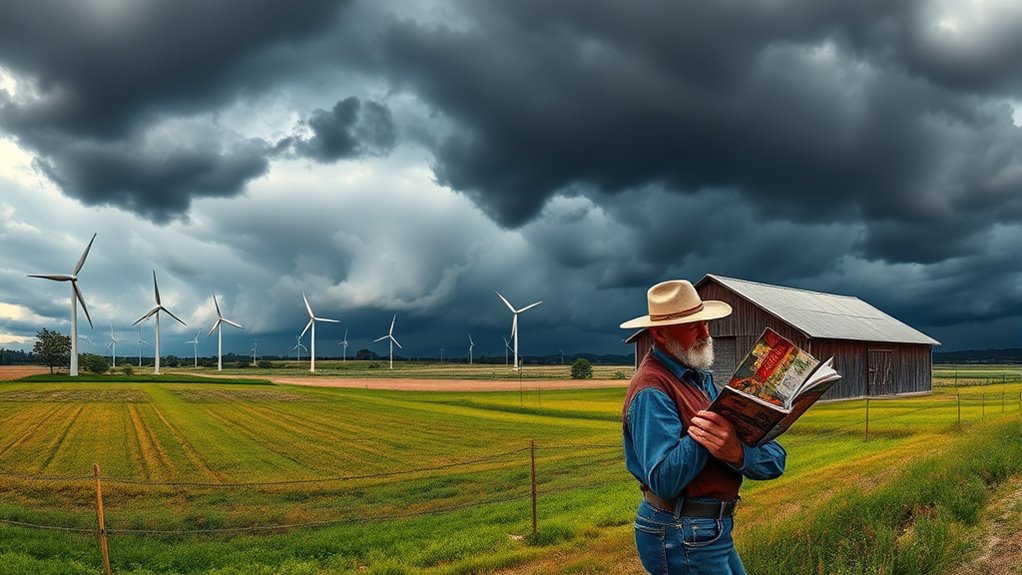
When choosing an insurance provider, you want to look at their reliability and how much you can trust them to be there when you need help. It’s also important to take into account how quickly they process claims, especially after extreme weather events. Comparing these aspects helps ensure you select a provider that will stand by you in tough times. Additionally, understanding how they handle claim processing times during busy periods like storms or floods can make a significant difference in your experience.
Provider Reliability and Trust
Have you ever wondered which farm insurance providers stand out when it comes to reliability and trust? You want a company that keeps its promises, especially during tough times. Reputable providers have a proven track record of consistently honoring claims and providing support when you need it most. Look for insurers with positive reviews from other farmers and industry recognition for their stability. You should also consider their transparency and communication—do they clearly explain policies and procedures? Trustworthy companies prioritize building strong relationships and demonstrate financial stability, so you feel confident in their ability to support your farm long-term. Ultimately, choosing a reliable provider means peace of mind, knowing they’ll stand by you through extreme weather events and beyond. For example, understanding Rhythm Failure can help you appreciate the importance of consistent support and reliability in your insurance provider.
Claim Processing Efficiency
Claim processing speed is a critical factor when choosing a farm insurance provider, especially during extreme weather events. Fast, efficient claims help you recover quickly and minimize losses. You should research how quickly providers typically settle claims—some companies offer same-day or next-day approvals, while others take weeks. Look for reviews and reputation reports that highlight their responsiveness during disasters. An insurer with a streamlined, transparent process will reduce your stress and uncertainty when you need help most. Consider providers known for clear communication and dedicated claims teams. Remember, a quick response isn’t just about speed; accuracy matters too, ensuring your claim is handled correctly the first time. Choosing an insurer with a reputation for efficient claim processing can make a significant difference in your recovery efforts.
Calculating Cost-Effectiveness and Premiums
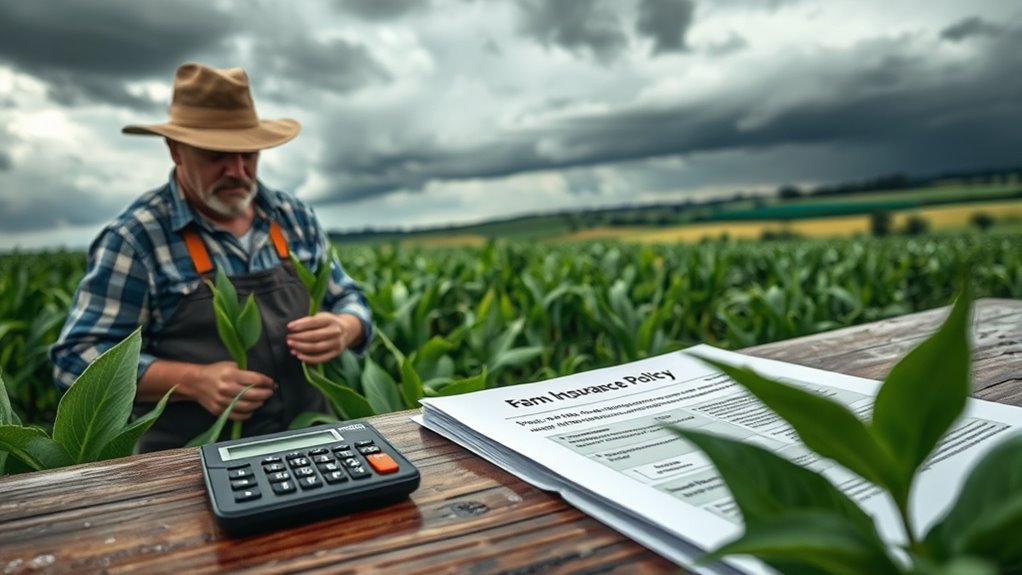
Calculating the cost-effectiveness and premiums of farm insurance for extreme weather involves analyzing the risk factors specific to your farm and the potential losses from climate-related events. You’ll want to assess past weather patterns, crop types, and vulnerability to events like floods, droughts, or storms. This helps determine the level of coverage you need and the associated costs. Consider the value of your assets and the likelihood of claims, which influence premium rates. Comparing quotes from different providers ensures you find a plan that balances affordability with sufficient protection. Keep in mind that higher premiums often offer broader coverage, but it’s essential to evaluate whether the coverage aligns with your risk profile and budget. Accurate calculations help you choose an insurance plan that’s both cost-effective and comprehensive. Additionally, understanding dog breed characteristics can assist in selecting the right insurance coverage if you own a breed with specific needs or vulnerabilities.
Preparing Documentation and Maintaining Records

Preparing thorough documentation and maintaining accurate records are essential steps in managing farm insurance for extreme weather. You want detailed records of your crops, livestock, expenses, and losses to support any claims. Keep photographs, receipts, and inventory lists organized and up to date. Regularly update weather data and note any unusual events that could impact your farm’s production. This documentation helps establish the extent of damages and verifies your claim’s validity. Using digital tools or apps can streamline record-keeping and guarantee data is secure. The more organized your records, the faster and smoother the claims process will be if disaster strikes. Accurate records not only support your insurance claims but also help you analyze vulnerabilities and improve your farm’s resilience. Incorporating best practices for record management can further enhance your preparedness and response efficiency.
Frequently Asked Questions
How Often Should I Review My Farm Insurance Policy?
You should review your farm insurance policy at least once a year, preferably before renewal time. Keep an eye on any changes in your farm operations, new risks, or updated coverage needs. After extreme weather events or significant farm modifications, review your policy promptly to make certain of adequate protection. Regular reviews help you stay informed, avoid gaps in coverage, and ensure you’re fully protected against the evolving risks of extreme weather.
Can I Customize Coverage for Specific Extreme Weather Events?
Absolutely, you can customize your coverage for specific extreme weather events—because who wouldn’t want tailored protection for the unexpected? You just need to talk with your insurer about adding riders or endorsements that cover floods, droughts, or hailstorms. It’s ironic, isn’t it? Planning for nature’s surprises is essential, yet many overlook the need for specialized coverage. So, don’t wait—personalize your policy before weather catches you unprepared.
What Claim Process Is Involved After a Weather-Related Loss?
After a weather-related loss, you should contact your insurance provider promptly to report the damage. Document everything thoroughly with photos and detailed descriptions. An adjuster will visit to assess the damage and determine the claim’s validity. You may need to provide additional documentation, like receipts or proof of loss. Once approved, you’ll receive compensation to cover repairs or replacements, helping you recover quickly from the storm’s impact.
How Do I Determine the Right Coverage Limits for My Farm?
To determine the right coverage limits, start by surveying your farm’s specific needs and risks. Consider crop value, livestock, equipment, and infrastructure. Consult with an insurance agent who can help you assess potential worst-case scenarios and costs. Don’t forget to compare policies, coverage options, and premiums. By balancing your budget with your farm’s unique vulnerabilities, you’ll pinpoint the perfect protection plan that prevents pitfalls and provides peace of mind.
Are There Discounts for Farms With Proactive Risk Management Measures?
Yes, many insurance providers offer discounts for farms that implement proactive risk management measures. You can qualify by installing advanced irrigation systems, reinforcing buildings, or adopting sustainable farming techniques. Be sure to document these efforts and discuss them with your insurer. By demonstrating your commitment to reducing risk, you increase your chances of securing discounts, lowering your premiums, and better protecting your farm against extreme weather events.
Conclusion
Choosing the right farm insurance isn’t just smart—it’s your secret weapon against nature’s fury! With the right coverage, you’ll be able to withstand storms, droughts, and floods that could wipe out entire farms overnight. Don’t leave your future to chance; armor up your farm like a fortress. The right policy will turn disaster into a minor hiccup, making you the superhero of your own farming story. Protect what matters most—your farm’s future depends on it!

